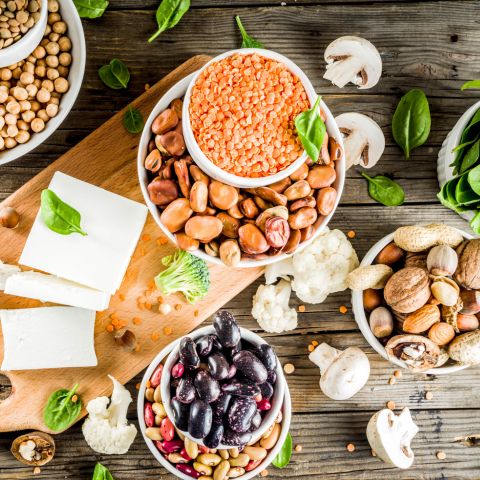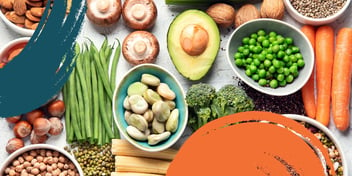Sophie Hung is a registered dietitian nutritionist who has been coaching clients for more than 12 years. She believes that food should both nourish our bodies and bring us joy. She was kind enough to share with us her journey toward a plant-based diet and a holistic lifestyle, as well as some tips and tricks for living well.
This post is the second in a three-part series about living a plant-based lifestyle. If you've thought about transitioning to a plant-based diet, here are some tricks to help make your journey a healthy and successful one.
![]()
Introduction
I studied for my Masters of Public Health Nutrition at Loma Linda University, which is a Seventh Day Adventist (SDA) school. Most SDAs practice some sort of plant-based diet, such as lacto/ovo vegetarian, lacto/ovo/pesco vegetarian, or vegan. I shopped at their vegetarian market and ate at their vegetarian cafeteria for the 2 years that I went to school there. I learned a lot about different vegetarian ingredients and dishes; in Food Service Class, we even learned to prepare Vegetarian meals. For those of you who aren't immersed in a plant-forward environment, here are some tips on making the transition to a well-balanced plant-based diet.
Steps to Success
Remember, a plant-based diet doesn't have to be all or nothing. Instead, focus on a cadence or combination that works for you. The goal is a plan that is both sustainable and healthy. Also, keep it positive.
Instead of thinking About what are you removing from your diet, think about what new foods you are introducing.
Take it Slow
To start, maybe try instituting a Meatless Monday. This can give you an opportunity to slowly introduce more plant-based foods into your diet.
Plan Your Meals
Take the time to plan your meals to ensure you're getting a good balance of nutrients. Include a combination of fruits, vegetables, whole grains, legumes, nuts, seeds and plant-based proteins. Consider using online resources or vegan cookbooks for recipe ideas and guidance.
Consult a Registered Dietitian
If you have specific dietary concerns or need personalized advice, it's advisable to consult a registered dietitian who specializes in Vegetarian/Vegan nutrition. They can help you create a personalized plan, and some might even have a cultural focus. I, for example, understand Asian and Latin food well, and I specialize in creating a customized, culturally sensitive program for my clients.

Incorporate Plant Proteins
After learning the many benefits of a plant based diet, I decided to start incorporating a lot of plant-based protein, such as organic sprouted tofu, edamame, tempeh, beans, lentils, nuts & seeds, plant-based milk, and plant-based yogurt. However, I still enjoy some meat here and there. Therefore, I decided to follow a Flexitarian diet, which is mostly plant-based with limited or occasional inclusion of meat. I try to eat meat only once a week and red meat once a month. You can definitely decide what frequency works best for you.
Stay Hydrated
Drink an adequate amount of water throughout the day to support overall health and well-being. Don't wait until you feel thirsty to drink some water. Staying hydrated helps curb cravings, improves alertness and helps digestion. Indications that you're not drinking enough water could include dry skin or eyes, headache or nausea, increased heart rate or feeling sluggish.
Key Ingredients for a Healthy Plant-Based Diet
As you're considering taking the first step toward adopting a plant-based diet, make sure you're aware of the essential components that will make your journey both delicious and nutritionally complete. Understanding what makes up a well-balanced plant-based diet is crucial to ensure you're not only meeting your body's nutritional requirements but also enjoying a diverse and satisfying range of meals.
It is possible to eat a balanced vegetarian or vegan diet by consuming a variety of plant-based foods that provide all the necessary nutrients your body needs, but it takes a lot of mindfulness and planning. Here are some components of a balanced diet:
Going Forward
Once you've started the transition to a plant-based diet, there are a few things to keep in mind to make sure you stay healthy.
Do Your Bloodwork Regularly
Check for Vitamin B12, Vitamin D, Calcium, Iron, CBC (including hemoglobin, hematocrit, serum ferritin, and transferrin saturation), Lipid panel, and Omega 3.
Listen to Your Body
Pay attention to how your body responds to the changes in your diet. If you experience any adverse effects, consult a healthcare professional.
Conclusion
Remember that every individual is unique, so what works for one person might not work for another. Your transition to a plant-based diet should be tailored to your preferences, lifestyle, and health considerations. Patience and experimentation are important as you discover new foods and find what works best for you. Key is making sure you are getting appropriate amounts of nutrition.
![]()




